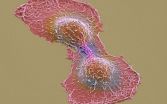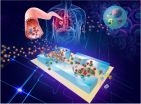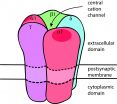Live and let-7: MicroRNA plays surprising role in cell survival
2014-10-07
(Press-News.org) Researchers at the University of California, San Diego School of Medicine have identified a microRNA molecule as a surprisingly crucial player in managing cell survival and growth. The findings, published in the October 7 issue of Cell Metabolism, underscore the emerging recognition that non-coding RNAs – small molecules that are not translated into working proteins – help regulate basic cellular processes and may be key to developing new drugs and therapies.
Specifically, principal investigator Albert R. La Spada, MD, PhD, professor of cellular and molecular medicine, chief of the Division of Genetics in the Department of Pediatrics and associate director of the Institute for Genomic Medicine at UC San Diego, and colleagues found that a microRNA known as let-7 controls autophagy through the amino acid sensing pathway, which has emerged as the most potent activator of mTORC1 complex activity.
Autophagy is a fundamental process used by cells to degrade unnecessary components in times of starvation, releasing energy stores that help promote cell survival. Cells have further adapted autophagy for other purposes as well, including recycling dysfunctional components, immune response to pathogen invasion, surveillance against cancer and maintenance of protein and organelle control in the central nervous system. MTORC1 is a critical protein complex that regulates energy consumption and growth in cells.
"The ability of let-7 alone to activate autophagy in this way was totally unknown and is very surprising," said La Spada. "As let-7 is known to be a tumor suppressor, its ability to activate autophagy could be a major component of its anti-tumor forming activity," though La Spada noted that autophagy may also contrarily promote tumor progression by supporting the altered metabolism of growing cancers.
With let-7 revealed to be a master regulator of metabolism, helping to modulate anabolic growth (the creation of new molecules in cells) with catabolic destruction (the breakdown of molecules in cells), researchers say the overall picture of how cells function becomes more fine-tuned but also more complicated.
"The fact that let-7 is opposing the action of the amino acid sensing pathway provides a glimpse into the complex pathway regulation at work in the cell, with microRNAs emerging as important factors for cells to maintain metabolic set points and overall homeostasis or a healthy equilibrium."
The therapeutic potential of let-7 remains to be explored. La Spada said he and colleagues have shown that a lentivirus encoding let-7 injected into mouse neurons promotes the autophagic turnover of toxic misfolded proteins associated with neurodegenerative disease.
"We also demonstrate that treatment with anti-let-7 can block autophagy and that this has physiological consequences (weight gain) in mice. It is possible that modulation of let-7 could be pursued for therapeutic application using very carefully targeted delivery systems, but further work will be necessary to see if this is practically possible."
INFORMATION:
Co-authors include Amy N. Dubinsky, Somasish Ghosh Dasidar, Cynthia L. Hsu, Rabaab Zahra, Steven Djakovic, Travis D. Ashe and Bradley E. Morrison, UCSD Department of Pediatrics; Sonia Duarte, Kimberlee M. Fischer and Luis Pereira de Almeida, University of Coimbra, Portugal; Christine C. Esau, Deidre A. MacKenna and B. Nelson Chau, Regulus Therapeutics; Brian Spencer and Eliezer Masliah, UCSD Department of Neurosciences; Bryce L. Sopher, University of Washington; and Terry Gaasterland, Scripps Institute for Oceanography and UCSD Institute for Genomic Medicine.
Funding support came, in part, from the National Institutes of Health (grants R01 AG03382, R01 EY014997, T32 AG000216, T32 GM008666 and P30 HD002274) and the Portuguese Foundation for Science and Technology.
[Attachments] See images for this press release:

ELSE PRESS RELEASES FROM THIS DATE:
2014-10-07
From AGU's blogs: Detecting avalanches from sounds we can't hear http://blogs.agu.org/geospace/2014/10/07/detecting-avalanches-sounds-cant-hear/
Researchers have developed a new avalanche monitoring method that uses sound below the range of human hearing to detect and track these deadly and destructive snow slides. The technique can detect an avalanche from the moment it starts, picking up the unheard thump of a rupture in the snowpack that can precede the snow cascade. It can then track the avalanche's path second by second down the mountain.
In a new study published ...
2014-10-07
When kids say "the darnedest things," it's often in response to something they heard or saw. This sponge-like learning starts at birth, as infants begin to decipher the social world surrounding them long before they can speak.
Now researchers at the University of Washington have found that children as young as 15 months can detect anger when watching other people's social interactions and then use that emotional information to guide their own behavior.
The study, published in the October/November issue of the journal, Cognitive Development, is the first evidence that ...
2014-10-07
LAWRENCE — Scientists have been laboring to detect cancer and a host of other diseases in people using promising new biomarkers called "exosomes." Indeed, Popular Science magazine named exosome-based cancer diagnostics one of the 20 breakthroughs that will shape the world this year. Exosomes could lead to less invasive, earlier detection of cancer, and sharply boost patients' odds of survival.
"Exosomes are minuscule membrane vesicles — or sacs — released from most, if not all, cell types, including cancer cells," said Yong Zeng, assistant professor ...
2014-10-07
You're obese, at risk for diabetes and cardiovascular disease, and so motivated to improve your diet that you've enrolled in an intensive behavioral program. But if you need to travel more than a short distance to a store that offers a good selection of healthy food, your success may be limited.
A new study from UMass Medical School and the Massachusetts Department of Public Health finds that not having close access to healthy foods can deter even the most motivated dieters from improving their diet, suggesting that easy access to healthy food is as important as personal ...
2014-10-07
Imagine attempting to trace your genetic history using only information from your mother's side. That's what scientists studying the evolution of the red fox had been doing for decades.
Now, University of California, Davis, researchers have for the first time investigated ancestry across the red fox genome, including the Y chromosome, or paternal line. The data, compiled for over 1,000 individuals from all over the world, expose some surprises about the origins, journey and evolution of the red fox, the world's most widely distributed land carnivore.
"The genome and ...
2014-10-07
Typhoon Vongfong strengthened into a Super typhoon on Tuesday, October 7 as NASA's Aqua satellite passed overhead.
On Oct. 7 at 0429 UTC (12:29 a.m. EDT) the Atmospheric Infrared Sounder called AIRS that flies aboard NASA's Aqua satellite captured cloud top temperature data on Super typhoon Vongfong. AIRS data very strong thunderstorms circling Vongfong's clear 27 nautical-mile wide eye. Those cloud top temperatures were colder than -62F/-53C indicating that they were high in the troposphere and capable of generating heavy rainfall. The bands of thunderstorms circling ...
2014-10-07
New Swedish research shows that plasmids containing genes that confer resistance to antibiotics can be enriched by very low concentrations of antibiotics and heavy metals. These results strengthen the suspicion that the antibiotic residues and heavy metals (such as arsenic, silver and copper) that are spread in the environment are contributing to the problems of resistance. These findings have now been published in the highly regarded journal mBio.
Antibiotic resistance is a growing medical problem that threatens human health worldwide. Why and how these resistant bacteria ...
2014-10-07
PHILADELPHIA — Nearly 60,000 Americans suffer from myasthenia gravis (MG), a non-inherited autoimmune form of muscle weakness. The disease has no cure, and the primary treatments are nonspecific immunosuppressants and inhibitors of the enzyme cholinesterase.
Now, a pair of researchers from the Perelman School of Medicine at the University of Pennsylvania have developed a fast-acting "vaccine" that can reverse the course of the disease in rats, and, they hope, in humans. Jon Lindstrom, PhD, a Trustee Professor in the department of Neuroscience led the study, published ...
2014-10-07
A new review of the way health care professionals emphasise weight to define health and wellbeing suggests the approach could be harmful to patients.
Author of the review article, Dr Rachel Calogero of the School of Psychology at the University of Kent, together with experts from other institutions and organisations, recommends that this approach, known as 'weight-normative', is replaced by health care professionals, public health officials and policy-makers with a 'weight-inclusive' approach.
Weight-inclusive approaches, such as the Health At Every Size initiative, ...
2014-10-07
Hamilton, ON (October 7, 2014) – Hospital visitors and staff are greeted with hand sanitizer dispensers in the lobby, by the elevators and outside rooms as reminders to wash their hands to stop infections, but just how clean are patients' hands?
A study led by McMaster University researcher Dr. Jocelyn Srigley has found that hospitalized patients wash their hands infrequently. They wash about 30 per cent of the time while in the washroom, 40 per cent during meal times, and only three per cent of the time when using the kitchens on their units. Hand hygiene rates ...
LAST 30 PRESS RELEASES:
[Press-News.org] Live and let-7: MicroRNA plays surprising role in cell survival





